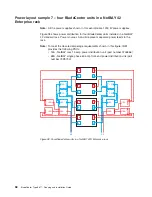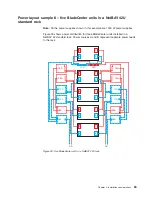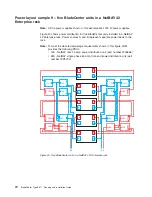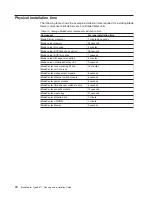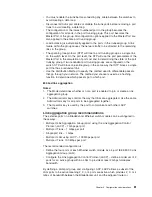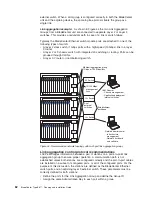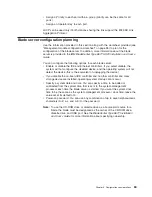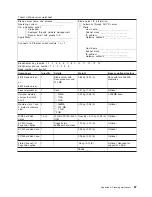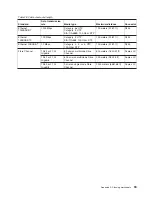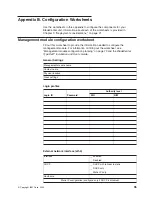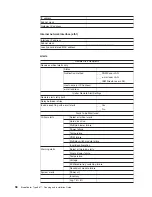
v
You
must
enable
the
trunk
before
connecting
any
cable
between
the
switches
to
avoid
creating
a
data
loop.
v
Disconnect
all
trunk
port
cables
or
disable
the
trunk
ports
before
removing
a
port
trunk
to
avoid
creating
a
data
loop.
v
The
configuration
of
the
lowest
numbered
port
in
the
group
becomes
the
configuration
for
all
ports
in
the
port
trunking
group.
This
port
becomes
the
Master
Port
of
the
group.
All
configuration
options
applied
to
the
Master
Port
are
also
applied
to
the
entire
port
trunking
group.
v
Load
balancing
is
automatically
applied
to
the
ports
in
the
trunked
group.
A
link
failure
within
the
group
causes
the
network
traffic
to
be
directed
to
the
remaining
links
in
the
group.
v
The
spanning
tree
protocol
(STP)
will
treat
a
port
trunking
group
as
a
single
link
on
the
switch
level.
On
the
port
level,
the
STP
will
use
the
port
parameters
of
the
Master
Port
in
the
calculation
of
port
cost
and
in
determining
the
state
of
the
port
trunking
group.
If
two
redundant
port
trunking
groups
are
configured
on
the
switch,
STP
will
block
one
entire
group
in
the
same
way
that
STP
blocks
a
single
port
that
has
a
redundant
link.
v
Use
the
Distribution
Method
to
specify
the
method
used
to
differentiate
packets
that
go
through
your
network.
The
method
you
choose
is
used
as
a
hashing
function
to
determine
which
packets
go
to
which
port.
802.3ad
link
aggregation
Notes:
1.
The
Mode
determines
whether
or
not
a
port
is
enabled
to
join
or
create
a
link
aggregation
group.
2.
The
Administrator
key
controls
the
way
that
links
are
aggregated.
Use
the
same
Administrator
key
for
all
ports
to
be
aggregated
together.
3.
The
Operator
key
is
used
by
the
port
to
communicate
with
other
LACP
switches.
Link
aggregation
group
recommendations
The
external
ports
on
a
BladeCenter
Ethernet
switch
module
can
be
configured
in
these
ways:
v
Multi-port
Link
Aggregation
Group
(LAG)
using
the
Link
Aggregation
Control
Protocol
(LACP)
–
1
Gbps
per
port
v
Multi-port
Trunk
–
1
Gbps
per
port
v
Single
port
link
–
1
Gbps
v
Multi-port
LAG
using
LACP
–
100
Mbps
per
port
v
Multi-port
Trunk,
100
Mbps
per
port
The
recommended
configuration
is:
v
Define
the
four
ports
of
each
Ethernet
switch
module
as
a
4-port
IEEE
802.3
Link
Aggregation
Group
(LAG).
v
Configure
the
Link
Aggregation
Control
Protocol
(LACP)
–
define
a
minimum
of
2
ports
for
an
active
group
within
a
LAG
to
provide
at
least
2
Gbps
full-duplex
bandwidth.
By
defining
a
LAG
port
group
and
configuring
LACP,
LACP
allows
a
subset
of
the
LAG
ports
to
be
active
meaning
2,
3,
or
4
ports
are
active
which
provides
2,
3,
or
4
Gbps
of
bandwidth
between
the
BladeCenter
unit
and
the
adjacent
router
or
Chapter
5.
Configuration
considerations
81
Содержание 8677 - BladeCenter Rack-mountable - Power...
Страница 1: ...BladeCenter Type 8677 Planning and Installation Guide GA27 4327 01 ERserver...
Страница 2: ......
Страница 3: ...BladeCenter Type 8677 Planning and Installation Guide GA27 4327 01 ERserver...
Страница 6: ...iv BladeCenter Type 8677 Planning and Installation Guide...
Страница 10: ...viii BladeCenter Type 8677 Planning and Installation Guide...
Страница 94: ...84 BladeCenter Type 8677 Planning and Installation Guide...
Страница 122: ...112 BladeCenter Type 8677 Planning and Installation Guide...
Страница 125: ......
Страница 126: ...Printed in USA GA27 4327 01...


